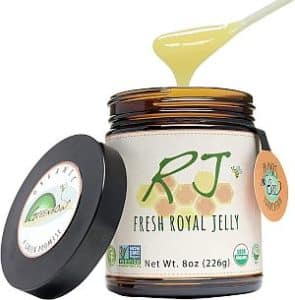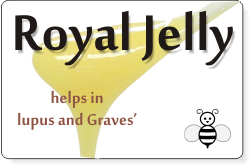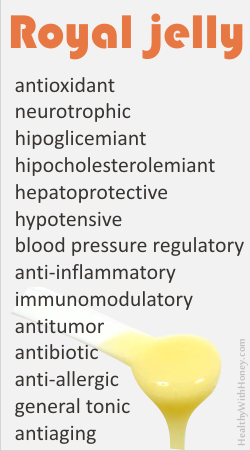Yes, it is. It increases testosterone levels in the blood, increases ejaculation, sperm count, and motility. It has metal chelating properties and may protect the liver and testicles against Cd-intoxication. It may also protect the testicles against damage produced by nicotine.
Does royal jelly raise testosterone?
It does. Consuming royal jelly induces higher testosterone and intensive spermatogenesis. (Kohguchi M et al., 2004). A 6-month ingestion of royal jelly improved erythropoiesis, glucose tolerance, and mental health. These may be due to secondary effects of testosterone with acceleration of conversion from DHEA-S (Morita et al., 2012).
♂️ Zinc contained in royal jelly can also contribute to the increase of testosterone. Zinc has been found to be very important in spermatogenesis and its deficiency is associated with a decrease in testosterone concentration.
♂️ The amino acid content in royal jelly was found to have a role in androgen homeostasis (Ronald Tamler et al., 2007)
Does royal jelly help with aging?
Yes. A 2024 study on mice showed that royal jelly regulates age-related disorders and improves gut function. It modulated serum lipids by reducing the levels of total cholesterol (TC), triglycerides (TG), and low-density lipoprotein cholesterol (LDL-C) and protected the liver by increasing antioxidant enzyme levels (study).

Long-term royal jelly consumption inhibits the age-associated decline in testicular function (Michihiro KOHGUCHI et al.)
Does royal jelly affect sperm?
It does. Studies have shown that royal jelly has a significant effect on seminal production, sperm count and motility. It ameliorates heat stress infertility and when women took it intravaginally, royal jelly and honey proved to be more effective than standard intrauterine insemination.
Asthenozoospermia is the medical term for reduced sperm motility. And sperm motility is the ability of sperm to swim towards the egg, through the female reproductive tract.
- Intravaginal honey and royal jelly are more effective than insemination.
In a randomized controlled trial conducted by Ahmed T Abdelhafiz et al., a group of women used midcycle pericoital vaginal applications of honey and royal jelly, and another group of women underwent a standard intrauterine insemination, for 3 cycles or until conception occurred for both groups. The problem was that men’s sperm had zero sperm motility.
The results were in favor of honey+royal jelly (8.1%), compared to insemination (only 2.6%) per cycle.
Conclusion? Intravaginal honey and royal jelly might be a simple and reasonably effective method of treating asthenozoospermia.
Are men less fertile in summer?
Yes. The effects of hot days in summer (heat stress) on sperm are: reduced sperm motility, increased abnormalities, and changes in the fluidity of the membrane as well as cell morphology. If you intend to have a child, avoid taking hot tubs with a temperature above 98.4 degrees, for 30 minutes per week .
- 🔬 In a study on rabbits kept under heat stress, with temperatures ranging from 23 to 36°C, royal jelly, in any dose, significantly boosted testosterone concentration and exhibited an increase in rabbits’ sperm concentration, total sperm output, sperm motility, live sperm, and normal sperm compared to the untreated controls.
It was concluded that royal jelly supplementation for heat-stressed male rabbits can counteract summer infertility and improve their physiological status (study conducted by A. M. El-Hanoun et al., 2014).
- 🔬 Royal jelly ameliorates heat stress infertility. Another study on rats showed that royal jelly can effectively ameliorate the experimental heat stress-induced infertility in rats through MDA (sperm malondialdehyde) concentration restoration, sperm characteristics and pre-implantation embryo development improvement (Noushin Mahdivand et al., 2018)
- 🔬Royal jelly increases seminal production. A trial evaluated the seminal quality and testicular morphometry of rabbits, after receiving royal jelly. While there was no increase in sperm concentration, gross motility, or individual motility, the ingestion of royal jelly produced positive results on the seminal production of males.
What supplements reduce cadmium?
Royal jelly has metal chelating properties due to its polyphenolic ingredients. In a recent study, royal jelly was able to decrease Cadmium accumulation in the testicular homogenate.
Cadmium is a heavy metal dangerous for its potential toxicity, which can increase the risk of cancer, cardiovascular disease, reproductive dysfunction, renal failure, neurological disorders, and osteoporosis.
We are exposed to Cd through inhalation and ingestion from contaminated water, food, and smoking, but also from several industrial products such as paints, batteries, fertilizers, and plastics. Once absorbed, Cd accumulates in various organs, especially the brain, liver, bones, kidneys, and testes.
A study by Rafa S. Almeer et al. from 2018, on mice, examined the efficacy of royal jelly against cadmium chloride (CdCl2)-induced testicular dysfunction. It was found that royal jelly is able to decrease Cd accumulation in the testicular homogenate.
Royal jelly exhibited an increase in levels of testosterone, luteinizing hormone (LH) and follicle stimulating hormone (FSH), ameliorated hormonal alterations, oxidative status, inflammatory response, and the apoptotic cascade produced following Cd-exposure. These effects may be due to its potent antioxidant activity.
Other study showed that royal jelly’s metal chelating properties are due to its polyphenolic ingredients.
Does nicotine affect your testicles?
It does. Royal jelly is one good supplement that protects the testicles against damages produced by nicotine.
🚬 The study “Royal‐jelly‐based apitherapy can attenuate damages to male reproductive parameter following nicotine administration” by Mahsa Nazar‐Zadeh et al., from 2022, showed that royal jelly upregulates the antioxidant status, inhibits the mitochondrial‐dependent apoptosis pathway, and increases the rate of proliferation. Which is, protects the testis against nicotine‐associated damages by antioxidant and anti‐apoptotic effects.
How much royal jelly should you eat?
The best results take organic, fresh royal jelly. The dose depends on the disease and can range from 1 to 5 g per day. For long term 1 g is enough. Always take it on empty stomach, sublingually, until complete dissolution.
***********************
References and further reading:
Ahmed T Abdelhafiz : Midcycle pericoital intravaginal bee honey and royal jelly for male factor infertility, https://pubmed.ncbi.nlm.nih.gov/18222449/
Morita et al.: Effect of royal jelly ingestion for six months on healthy volunteers. Nutrition Journal 2012 11:77. https://pubmed.ncbi.nlm.nih.gov/22995464/
Sameh A Abdelnour et al., Responses of sperm mitochondria functionality in animals to thermal stress: The mitigating effects of dietary natural antioxidants, https://pubmed.ncbi.nlm.nih.gov/35754099/
https://www.cabidigitallibrary.org/doi/full/10.5555/20133121551
Featured picture source pixabay.com




